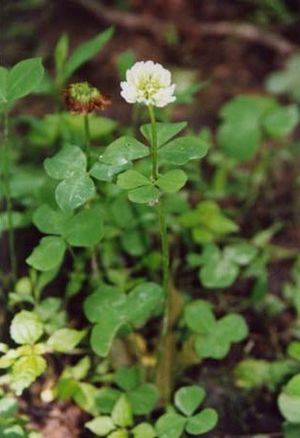Running buffalo clover facts for kids
Quick facts for kids Running buffalo clover |
|
|---|---|
 |
|
| Conservation status | |
| Scientific classification | |
| Genus: |
Trifolium
|
| Species: |
stoloniferum
|
The running buffalo clover (Trifolium stoloniferum) is a special kind of clover. It is a perennial plant, meaning it lives for many years. This clover is native to the eastern and central parts of the United States. It is also an endangered species, which means it is in danger of disappearing forever.
For a long time, from 1940 to 1985, people thought this clover was gone completely. But then, two groups of them were found in West Virginia! Since then, more groups have been found, but it is still one of the most threatened plants in North America.
What Does Running Buffalo Clover Look Like?
This plant has straight, single stems that grow flowers. These stems are usually about 10–50 centimetres (4–20 in) (4 to 20 inches) tall. At the very top of each stem, you will find a round flower head. Two leaves grow right below this flower head. These top leaves are usually bigger than other leaves on stems without flowers.
The flower heads are white, but sometimes they have a hint of purple. They are about 2 to 2.5 cm (about 1 inch) wide. Like other clovers, the running buffalo clover has leaves made up of three small parts, called leaflets.
A cool thing about this clover is that it sends out long, creeping stems called stolons from its base. These stolons grow along the ground and can take root, helping the plant spread. Both the stems and leaves of this clover are smooth and do not have any hairs. It usually flowers from mid-May to June and then produces seeds in July.
Where Does Running Buffalo Clover Live?
Scientists believe that this plant originally grew in rich soils. It liked open areas found between forests and prairies. Large animals like bison probably helped keep these areas open. As bison moved along their trails, they would graze and disturb the ground, which helped the clover grow.
Today, you can find running buffalo clover in West Virginia, Ohio, Kentucky, Indiana, Pennsylvania, and Missouri. There are also old records of it being found in Illinois, Kansas, and Arkansas.
Most of the groups of running buffalo clover that are left are small and spread out. They are often found again in lightly shaded woodlands, especially near streams. Sometimes, they are even found in the lawns of old homes or in cemeteries.
Why Is Running Buffalo Clover Endangered?
Old records show that running buffalo clover used to be very common in some areas. However, it quickly disappeared when early settlers arrived. We don't know all the reasons why this plant declined. But it seems to be connected to the disappearance of large plant-eating animals, like bison, from its habitat.
This clover likely depended on the ground being disturbed by these big animals. Many old records of the clover were found near bison "licks" (places where bison would lick salt from the ground) and trails. Other reasons for its decline might include new plant species taking over its space or the loss of its natural habitat.
Running buffalo clover is also unique because it doesn't seem to work with certain helpful bacteria called Rhizobia. Most other clovers have these bacteria on their roots, which helps the plant get more nitrogen from the soil. Scientists are still trying to understand why this clover is different.


